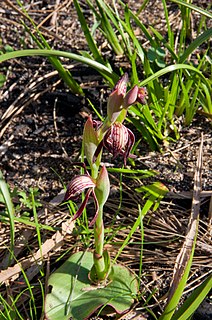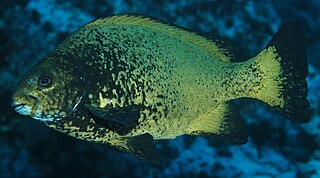
Chevrotains, also known as mouse-deer, are small ungulates that make up the family Tragulidae, the only extant members of the infraorder Tragulina. The 10 extant species are placed in three genera, but several species also are known only from fossils. The extant species are found in forests in South and Southeast Asia, with a single species in the rainforests of Central and West Africa. They are solitary or live in pairs, and feed almost exclusively on plant material. Chevrotains are the smallest hoofed mammals in the world. The Asian species weigh between 0.7 and 8.0 kg, while the African chevrotain is considerably larger at 7–16 kg (15–35 lb).

Tibouchina Aubl. is a Neotropical flowering plant genus in Melastomataceae Juss. that contains approximately 240 species. Species of this genus are herbs, shrubs or trees and typically have purple flowers. They are native to Mexico, the Caribbean, and South America where they are found as far south as northern Argentina. Members of this genus are known as glory bushes, glory trees or princess flowers. The name Tibouchina is adapted from a Guianan indigenous name for a member of this genus [2]. A recent systematic study has shown that this genus is paraphyletic.

The black phoebe is a passerine bird in the tyrant-flycatcher family. It breeds from southwest Oregon and California south through Central and South America. It occurs year-round throughout most of its range and migrates less than the other birds in its genus, though its northern populations are partially migratory. Six subspecies are commonly recognized, although two are occasionally combined as a separate species, the white-winged phoebe.

The black myotis, is a vesper bat species from South and Central America.

Kennedia is a genus of plants comprising 16 species, all native to Australia. They are evergreen climbing plants with woody stems. They usually have trifoliate leaves and pea-type flowers of various colours from pink to dark red and yellow to black. The genus was named by Étienne Pierre Ventenat after John Kennedy, a partner in the renowned firm of nurserymen, Lee and Kennedy of Hammersmith, London.
The putative Wych Elm cultivar Ulmus glabra 'Latifolia Nigricans' was first described, as Ulmus campestris latifolia nigricans, by Pynaert in 1879. Pynaert, however, did not specify what species he meant by U. campestris. The tree was supplied by the Späth nursery of Berlin in the late 19th century and early 20th as Ulmus montana latifolia nigricans. Späth, like many of his contemporaries, used U. montana both for Wych Elm cultivars and for those of the U. × hollandica group.

Onchidella is a genus of small, air-breathing sea slugs, shell-less marine pulmonate gastropod molluscs in the family Onchidiidae.

Acacia nigricans is a species of wattle which is endemic to an area on the south coast of Western Australia. It is a shrub which ranges from 0.4 to 2 metres in height. It produces yellow, globular flowers between mid-winter and late spring.

The tree martin is a member of the swallow family of passerine birds. It breeds in Australia, mostly south of latitude 20°S and on Timor island. It is migratory, wintering through most of Australia, New Guinea, Indonesia east of the Wallace Line and the Solomon Islands. It is a vagrant to New Zealand, where it has bred, and New Caledonia. This species is frequently placed in the genus Hirundo as Hirundo nigricans.

Tragulus is a genus of even-toed ungulates in the family Tragulidae that are known as mouse-deer. In Ancient Greek τράγος (tragos) means a male goat, while the Latin diminutive –ulus means 'tiny'. With a weight of 0.7–8.0 kg (1.5–17.6 lb) and a length of 40–75 cm (16–30 in), they are the smallest ungulates in the world, though the largest species of mouse-deer surpass some species of Neotragus antelopes in size. The mouse-deer are restricted to Southeast Asia from far southern China to the Philippines (Balabac) and Java. Following recent taxonomic changes, several of the species in this genus are poorly known, but all are believed to be mainly nocturnal and feed on leaves, fruits, grasses, and other vegetation in the dense forest undergrowth. They are solitary or live in pairs, and the males have elongated canine teeth that are used in fights. Unlike other members of their family, the Tragulus mouse-deer lack obvious pale stripes/spots on their upper parts.

Pyrorchis, commonly known as beak orchids, is a genus of flowering plants in the orchid family, Orchidaceae and is endemic to Australia. It contains two species which were previously included in the genus Lyperanthus, also known as beak orchids. Both species have fleshy, oval leaves and form colonies which flower profusely after bushfires.
S. nigricans may refer to:
C. nigricans may refer to:
H. nigricans may refer to:
M. nigricans may refer to:
O. nigricans may refer to:

Girella is a genus of sea chubs mostly native to the Pacific Ocean with a smaller presence in the Atlantic oceans.
Acanthocnemus nigricans is a species of Polyphaga beetle, the only species in the monotypic family Acanthocnemidae. The single species of Acanthocnemidae, Acanthocnemus nigricans, is native to Australia.

Stenaria is a genus of flowering plants in the family Rubiaceae. It is a small genus, consisting of around six species native to the United States, Mexico, and The Bahamas. All species of Stenaria are restricted to Mexico and the southwestern United States, except for the wide-ranging Stenaria nigricans which extends northward and eastward.












